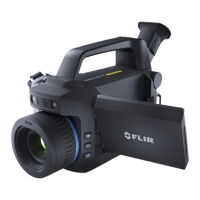Measuring temperatures10
2. On the toolbar, select Select > Delta. This displays a toolbar.
3. Select Set alarm on delta. This displays a dialog box.
4. In the dialog box, you can define the settings for the alarm.
• Alarm condition: The condition that triggers the alarm (Above or Below). Select
Off to deactivate the alarm.
• Alarm limit: The temperature value that will be the critical condition when an alarm
is triggered or not.
5. To close the dialog box, push the Back button.
10.3 Temperature range
The camera is calibrated for different temperature ranges. The available temperature
range options depend on the camera model.
For accurate temperature measurements, you must select a temperature range that
matches the expected temperature of the object you are inspecting.
To change the temperature range, do one of the following:
• Push the Temperature range button and then select a temperature range by using the
joystick or touching the screen. See also section 6.9 Temperature range.
• On the Settings menu, select Camera temperature range. This displays a menu where
you can select the temperature range.
10.4 Adjust the temperature scale
Adjusting the temperature scale can make it possible to detect anomalies and smaller
temperature differences in the part of the image of interest.
For instructions on how to manually adjust the temperature scale, see section 7.3 Ther-
mal image adjustment.
10.5 Measurement parameters
For very accurate measurements, it is important to set the measurement parameters.
Note During normal operation there is typically no need to change the default meas-
urement parameters, see section 10.5.2 Recommended values.
10.5.1 Types of parameters
The camera can use these measurement parameters:
• External IR window compensation, i.e., the temperature of any protective windows,
protective shields, etc., that are set up between the camera and the object of interest.
If no protective window is used, this value is irrelevant and should be left inactive.
• Object distance, i.e., the distance between the camera and the object of interest.
• Atmospheric temperature, i.e., the temperature of the air between the camera and the
object of interest.
• Relative humidity, i.e., the relative humidity of the air between the camera and the ob-
ject of interest.
• Reflected temperature, which is used when compensating for the radiation from the
surroundings reflected by the object into the camera. This property of the object is
called “reflectivity.”
• Emissivity, i.e., how much radiation an object emits, compared with the radiation of a
theoretical reference object at the same temperature (called a “blackbody”). The op-
posite of emissivity is reflectivity. The emissivity determines how much of the radiation
originates from the object as opposed to being reflected by it.
#T810605; r. AD/92464/92464; en-US
52

